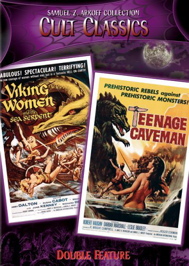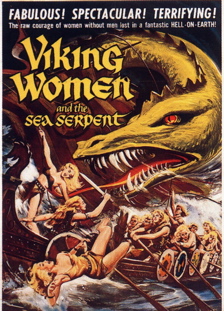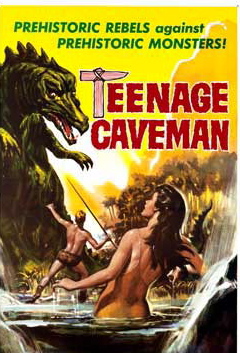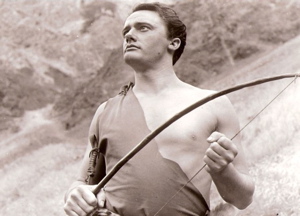| Release List | Reviews | Price Search | Shop | Newsletter | Forum | DVD Giveaways | Blu-Ray/ HD DVD | Advertise |
| Reviews & Columns |
|
Reviews DVD TV on DVD Blu-ray International DVDs Theatrical Reviews by Studio Video Games Features Collector Series DVDs Easter Egg Database Interviews DVD Talk TV DVD Talk Radio Feature Articles Columns Anime Talk DVD Savant HD Talk Horror DVDs Silent DVD
|
DVD Talk Forum |
|
|
| Resources |
|
DVD Price Search Customer Service #'s RCE Info Links |
|
Columns
|
 |
Teenage Caveman |

Teenage Caveman & The Saga of the Viking Women and Their Voyage to the Waters of the Great Sea Serpent Lionsgate B&W Street Date April 25, 2006
|
|
Roger Corman directed nine movies released in 1957 and five that came out in 1958. That's more than one every two months, which adds new meaning to the word prolific. This fourth entry in the Samuel Z. Arkoff Cult Classics Collection pairs two Corman features that show him trying to make the most with his minimalist budgets and learning some hard lessons in the process.
The Saga of the Viking Women and Their Voyage to the Waters of the Great Sea Serpent
1957 / 1:37 flat full frame / 66 min.
Starring Abby Dalton, Susan Cabot, Bradford Jackson, June Kenney, Richard Devon, Betsy Jones-Moreland, Jonathan Haze, Jay Sayer, Sally Todd, Gary Conway, Michael Forest
Cinematography Monroe P. Askins
Art Direction Bob Kinoshita
Special Effects Irving Block, Louis DeWitt, Jack Rabin
Film Editor Ronald Sinclair
Original Music Albert Glasser
Written by Irving Block, Lawrence L. Goldman
Produced by Samuel Z. Arkoff, Roger Corman, James H. Nicholson
Directed by Roger Corman
A long-time favorite title for trivia games, The Saga of the Viking Women and Their Voyage to the Waters of the Great Sea Serpent was usually shortened as seen on the poster above. It's also usually dismissed as an interesting failure, as Viking epics generally need high production values to succeed, unless one has the visual skills of a Mario Bava as a backstop. A drab screenplay makes 66 minutes seem like a long time, although viewers with an appreciation of late-50s wanna-be actors can get a good look at the coterie of talent that gravitated around Corman's five and six- day shoots.

Roger Corman's stock resources let him down in this one; the familiar rocks of San Fernando's Stony Point and the Bronson Caverns quarry just don't look very "Viking" - when the cast is hiking down the dusty trails in their hot furs, getting sunburned, we expect to see them pass a western filming unit going the other way. The cast is certainly gung-ho and athletic (Montana native Michael Forest is darn good on a horse) but the whole exercise plays like a high school effort.
In his autobiography Corman spelled out his big mistake: He let his scenarist-special effects man Irving Block talk him into the concept with a series of fancy storyboards. Chances are that 50% of the budget for this film went into about ninety seconds of miniatures and mattes (that are okay, but not great) and maybe six minutes of completely botched rear-projection. Block shot background plates for the scenes with the Viking boat on the high seas, but more R&D was needed, as the scale of the water and the inflexibility of the setups makes the scenes look silly. Since the RP screen isn't big enough Corman has to keep his angles too tight on the boat. The puppet sea monster in the background action is often so big that we can't get a clear look at it.
I'm sure Corman's main concern was that he had paid out hard cash for a lot of fancy effects and barely gotten enough shots to support a ragged continuity - the sailing part of the movie is over in a flash and we're once again back to people trudging through Griffith Park. 1
Working with a relatively big cast, many of whom are on screen in almost every scene, also drags Viking Women down. Corman shoots everything by the numbers, as if just happy to get his shots in the can - besides a few effects clips, there just aren't any memorable scenes. The laughable script is one howlingly bad line reading after another. Names are even more functional than in Tony Curtis' Universal swashbucklers: "Desir" = Desire; "Enger" = Anger. "Asmild" = .... something, I'm sure.
Bad Movie fanatics can jeer, while anyone who has tried to make a film is more likely to admire the spirited effort put in by a loyal cast: They just want to be in the movies, and they're not quitters. Corman reportedly kept things moving so fast that no one had a chance to get bored. They also may not have had an opportunity to think about what a loser film called Viking Women would (or wouldn't) do for their résumès. Most "Z" pictures are the career equivalent of Wake Island.
Corman's cast includes plenty of talented hopefuls. Star Abby Dalton (Rock all Night) energizes the frame with or without bad dialogue, and has striking good looks that don't date. Corman's perennial 'bad girl' Susan Cabot (Sorority Girl, The Wasp Woman) plays a wicked character but doesn't have much of a chance to apply any coloration. Likewise, familiar faces June Kenney (Earth vs. the Spider), Gary Conway (I was a Teenage Frankenstein) and Sally Todd (Frankenstein's Daughter) haven't much to do. This appears to be statuesque Betsy Jones-Moreland's (The Last Woman on Earth) advent into the Corman world and she lends an air of class to the proceedings. Richard Devon (Blood of Dracula) also gives a good accounting of himself as a fierce "Grimolt" king. Jay Sayer (Machine Gun Kelly) takes the Jay Robinson Prize for Garish Overplaying -- Corman must have thought Jay funny to keep re-using him. Finally, later busy actor (and now a busy voice actor) Michael Forest (Beast from Haunted Cave) is the evil King's key stooge. His main contribution is having the least convincing haircut.
Editor Ronald Sinclair has little choice but to leave in shots with microphone shadows on the actors. Albert Glasser's "big sound" music score reminds us a bit of the Dirge March of Jennifer Jones in Tiomkin's Duel in the Sun.

Teenage Caveman
1958 / 1:37 flat pan-scan / 65 min. / Prehistoric World
Starring
Cinematography Floyd Crosby
Art Direction
Film Editor Irene Mora
Original Music Al Glasser
Written by R. Wright Campbell
Produced by Samuel Z. Arkoff, Roger Corman, James H. Nicholson
Directed by Roger Corman
Corman ran into another kind of problem the next year with this ambitious Cave Man story. He used the general One Million B.C. format -- previously considered fit only for jokes about Victor Mature and Carol Landis being upstaged by lizards -- as a clever O. Henry-type tale with a twist at the conclusion. It had a potentially sensible title -- Prehistoric World. According to Corman, good old Sam Arkoff changed the title (the edits are visible where he slugged in the replacement, which actually reads "Teenage Cave Man") without even telling him. Thus, a potentially thoughtful story looks like one of A.I.P.'s teenaged monster movies, which were the rage for a little less than a year. Teenage Caveman gives us another look at rising star Robert Vaughn, this time playing a primitive intellectual chafing at the restrictions of his uptight caveman community. He must have fainted dead away when he read the title change. Not to worry, Bob, two years later you'll be nominated for best supporting actor for The Young Pleistocenes, I mean, The Young Philadelphians.
Anyone who gets beyond the title and the pitiful caveman costumes will discover that Teenage Caveman actually has a great little story. Writer R. Wright Campbell's story is a gem that has relevance even without the last-second twist surprise. Young Robert Vaughn walks through the picture with a permanent smirk on his face, dissatisfied by the arbitrary rules of his society. Campbell lays it out quite simply: Three wise men guard symbolic representations of the "three gifts" that make men what they are: Fire, the wheel, and a clay model that the third wise man repeatedly sculpts and then tears down: The gift for creation/destruction.
The rest of the rules are all no-no's setting limits on curiosity and movement, and a law to kill any stranger that might wander in from outside the clan. Vaughn's rebel cave dweller hasn't got time for his girlfriend. She just wants to snuggle with him in a private cave, and is basically around to skinny-dip as justification for the poster image. He's basically an artist like his dad and instead wants to see the other side of everything. In a telling episode, a wounded man from the "Burning Plains" (another forbidden territory) rides in on a horse (something the clan has never seen before) with only one word on his lips: Peace. Against Vaughn's pleadings, the villagers summarily execute him. Ignorance and fear are the order of the day, and the Law must be obeyed even if it makes no sense.
(start spoiler)What R. Wright Campbell does here is basically invent the "forgotten future" idea exploited later in the Planet of the Apes Movies. The big twist is that Robert Vaughn's curiosity uncovers a shocking truth about the caveman society -- it isn't prehistoric, it's post-Apocalyptic! The God that Kills with a Touch turns out to be an old human from our age wearing an encrusted radiation suit (no longer needed) to scare off the primitives, who have forgotten history entirely. Vaughn and his father (a convert to sonny-boy's radical ways) find a book belonging to the Old Man, which has text and printed images completely alien to them: The United Nations, a Nuclear mushroom cloud.
The surprise is handled very nicely. Considering how lame-brained and unimaginative most exploitation films at this level are, it's brilliantly handled. Teenage Caveman has the reputation of a thinking man's creature feature -- well, a Cormanesque liberal thinking man's creature feature. Corman's thematic preoccupation with breaking barriers and curiously snooping into unknown realms may start right here.
(end spoiler)The production is perfectly pitched to Roger Corman's budgetary limits. We see maybe twenty cave dwellers with costumes that range from okay fur tunics to what look like old bathroom throw rugs. The whole movie is again filmed in Bronson Caverns or up at Stony Point. This time around Corman uses a lot of stock footage, some of which looks like the standard One Million B.C. alligators, Tegus and monitor lizards with extra horns glued on. Other shots appear to come from the Unknown Island library of anemic Man-in-suit-a-saurs. A concluding montage becomes incestuous, with a shot of a man (Paul Dubov) stumbling out of the radioactive fog of Day the World Ended, and a curious broad-daylight shot of The She-Creature.

Robert Vaughn toodles around the jungle pathways of a Pasadena aboretum, playing his little homemade flute (he's an artist at heart) instead of "Knockin' great big Mon-stahs dead on their knees." 2 As Sarah Marshall, our leading lady became a popular Broadway actress and a very busy TV performer. The Keeper of the Fire is Robert Shayne; I believe he gets to play his entire role sitting down. Jonathan Haze and Beach Dickerson play cavemen as needed, taking plenty of tumbles in the rocks (ouch). Dickerson remembers getting killed three times as three different characters ... the blonde caveman who drowns in quicksand, the Man from the Burning Plains, and a bear. He's almost like the character Kenny from South Park. Favorite Barboura Morris (A Bucket of Blood) is in there too, but isn't easy to spot beyond a handful of shots.
Anybody thinking that modern pictures are more sophisticated than Teenage Caveman should take a look at the IMDB plot descriptions for M. Night Shyamalan's 2004 The Village. Once a ripe chestnut "secret twist" story like this one has been done, a new movie trying to repeat it really has to be exceptional. I understand there were audiences that responded well to The Village; I saw it at a screening where an audible groan could be heard. You put us through a convoluted cheat of a story and this is your big surprise? And I doubt that many in the audience for The Village were aware of Teenage Caveman.
Lionsgate's Samuel Z. Arkoff Cult Classics Collection DVD double bill of Teenage Caveman and The Saga of the Viking Women and Their Voyage to the Waters of the Great Sea Serpent is the most troubling release yet in the series. The Viking Women is a flat full frame transfer of middling quality from the 1990s. An old-fashioned non-digital videotape "hit" happens right in the middle of the titles, sending odd color patterns across the screen in this B&W movie. Not a good sign. The rest of the film looks okay. The blocking and framing matte off well on a wide-screen monitor, although the picture quality suffers considerably. Otherwise, there are acres of empty space above and below the intended picture area. Of course, the claustrophobic framing in the rear-projection boat scenes is not a transfer problem, as explained above.
Teenage Caveman is a complete botch in which the basic problem is still hidden. Some reference books list the widescreen process Superama, said to be a variation on SuperScope (1:2.0) that takes an even narrower 1:2.35 slice out of a normal frame. That same year Corman did direct I, Mobster, a bona fide CinemaScope film. But that was for another independent producer. I could be wrong but I don't think he made the jump to anamorphic until the Panavision House of Usher in 1960. The same widescreen resource book lists two other 1958 Cormans as being in Superama, and one of them is Machine Gun Kelly.
I saw a widescreen 35mm print of that gangster picture at a studio screening in 1978 and jumped up to tell the projectionist that he'd made a mistake, that it was a flat film; he responded by rolling out a reel and showing me the standard squeezed SuperScope 1:2.0 frame, with the black stripe along the right side of the picture. Apparently A.I.P. released Kelly in two versions, giving exhibitors a choice of "Scope" for more money -- what they got was a picture with chins and foreheads cut off! Teenage Caveman appears to be better designed to be blown up, and it's obvious that the title sequence is definitely meant to be anamorphic -- in projection.
The copy of Teenage Caveman on this disc is a crummy Pan-Scan of the already cropped Superama (SuperScope) image. Characters are consistently cropped halfway or all the way off the screen. The titles are squeezed, consistent with Savant's reasoning. What isn't consistent are the many stock shots of fake dinosaurs from the earlier, pre-widescreen era movies. Some of them don't look as if they've been cropped! With that observation, I'm ready to hear somebody else's brainstorm on what we're watching. Whatever it is, I don't like it.
Teenage Caveman is followed by a Tele-world logo that other sites have cited to establish the vintage of these unsatisfactory presentations. I've already vented my sour opinion of the image quality of these Lionsgate releases with the concurrent double bill release Day the World Ended & The She-Creature. As I said in that review, we love 50s Roger Corman classics. The only way to voice our displeasure is to rent rather than buy these substandard discs.
On a scale of Excellent, Good, Fair, and Poor,
|
The Saga of the Viking Women and Their Voyage to the Waters of the Great Sea Serpent rates: Movie: Fair Video: Fair + Sound: Good Supplements: |
Teenage Caveman rates:
Movie: Good - Video: Poor Sound: Good Supplements: |
Reviewed: May 6, 2006
Footnotes:
1. But Corman didn't drop Irving Block and his sometime associate Jack Rabin -- the next year he did another "big effects" movie with them, and got it finished in record time: War of the Satellites. I've only seen a trailer for that film, which was chock full of effects shots; perhaps those are all the effects that are in the picture!
Return
2. From a pop song released two years later, which ought to be rescored into this film's soundtrack.
Return
Review Staff | About DVD Talk | Newsletter Subscribe | Join DVD Talk Forum
Copyright © DVDTalk.com All rights reserved | Privacy Policy | Terms of Use
|
| Release List | Reviews | Price Search | Shop | SUBSCRIBE | Forum | DVD Giveaways | Blu-Ray/ HD DVD | Advertise |





